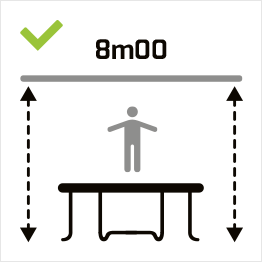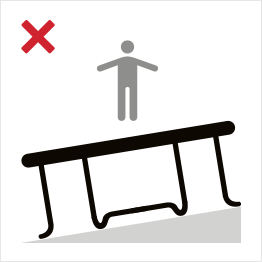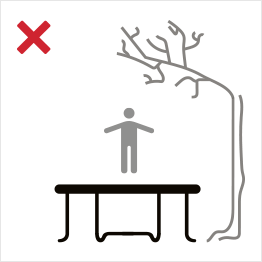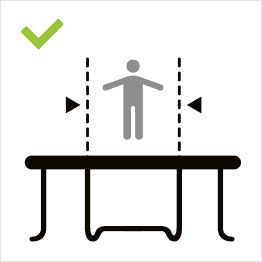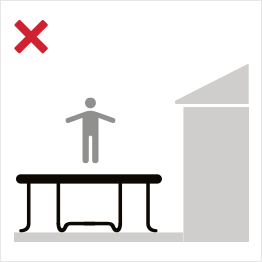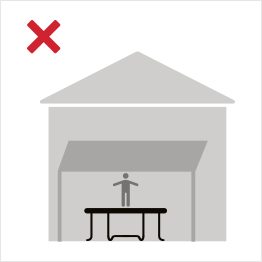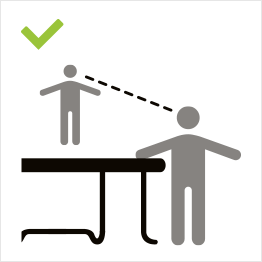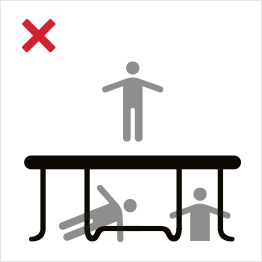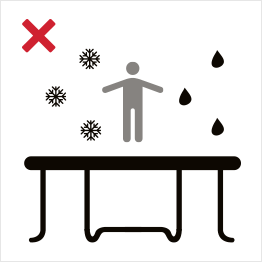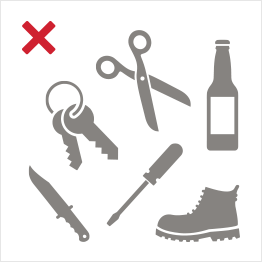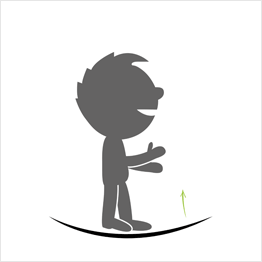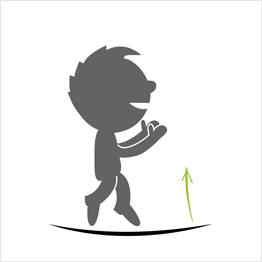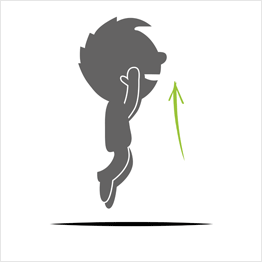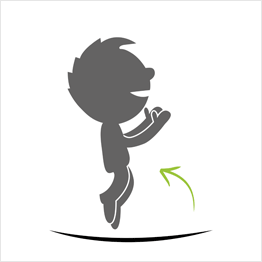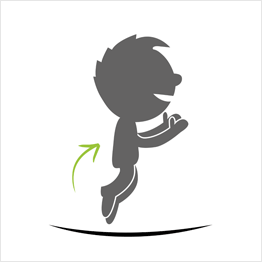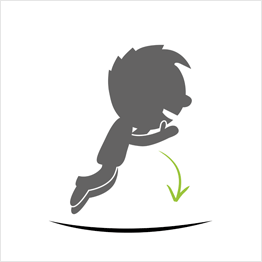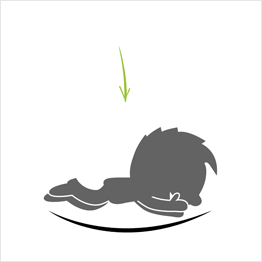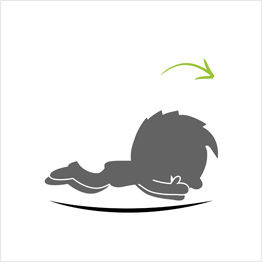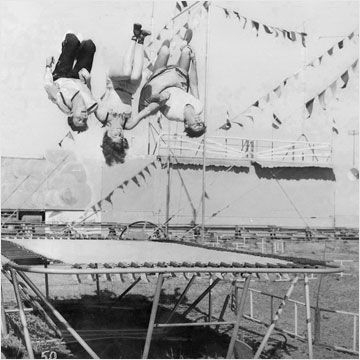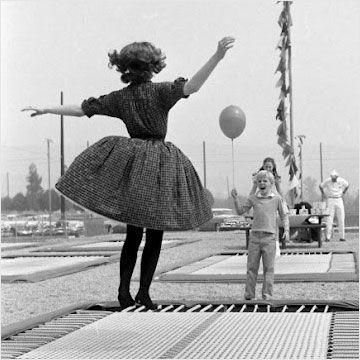Product successfully added
You can modify the quantity in the order summary, once you have clicked on 'Order'
There are 0 items in your cart There is 1 item in your cart
Leisure Trampoline Discovery Guide
On a trampoline, safety comes first!
Whether for playful or athletic use, trampoline fun takes place in the garden! Used by children, teens, and adults, the trampoline lets you have fun while getting exercise at the same time... in a safe environment! The trampoline is without a doubt the outdoor leisure activity that offers one of the most secure safety enclosures.
The trampoline jumping mat is surrounded by a frame pad to prevent any user contact with the springs or metal frame. A safety enclosure surrounding the trampoline should be installed to prevent users from falling off the trampoline.
Trampolines may be used at no risk provided the installation and usage guidelines are closely followed and respected.
We recommend that our customers read the trampoline installation guide that is delivered with the trampoline to be well-informed on the installation, usage, and safety measures to enforce. One of the characteristics of trampolines, and especially our round and oval models, is that the jumper always lands in the center of the jumping mat, which is why we strongly recommend that no more then one jumper at a time be allowed on the trampoline.
Each of our trampolines is equipped with the finest-quality frame pad (up to 31 mm in thickness) that covers the frame and springs, with no gap between the pad and the jumping mat, so that the jumper is completely protected if he / she lands outside the jumping mat.
With regards to the quality that goes into the design and manufacturing of our trampolines, our products have been approved by the German Technical Inspection Association TUV/GS, and comply with French trampoline standards NF EN 71-14 (trampolines for family use), NF EN 13219 (trampolines for gymnastics), and NF EN 913 (safety standards), all of which testify to the high levels of safety our products provide our French and European customers.
Your France Trampoline equipment will last much longer than its warranty. We know this from our many years of experience as trampoline specialists.
Trampoline installation guidelines
- The trampoline should be placed on a flat, well-lit surface.
- Outdoors, the trampoline is designed for use on grass or sand. It is not recommended that you install a trampoline on a hard surface such as a terrace.
- Make sure that there is an 8-meter clearance above the trampoline, whether installed indoors or outdoors.
- The installation of the safety enclosure and frame pad are compulsory, and these installations should be carefully inspected once they are in place.
- Inspect the trampoline before using it each time and replace any broken, defective, worn, or missing parts with an identical spare part.
- Make sure that the jumping mat is clean and dry to keep users from slipping.
- Indoors, it is advisable to install a protective mattress on the floor around the trampoline.
- Check to be sure that no harmful objects are located near the trampoline (e.g. tree branches, electric cables, walls...). Under no circumstances should any object, individual, or animal be underneath the trampoline when it is in use.
Trampoline usage guidelines
- Do not allow more than one person at a time to use the trampoline. The presence of two or more jumpers on the mat could result in injuries due to collisions or by a jumper losing balance and falling off the trampoline. Indeed, one of the primary causes of trampoline incidents is the presence of two people with different body weights on the trampoline at the same time. When jumping, the heavier of the two could eject the lighter person from the jumping mat if the safety enclosure is not properly installed, or else collide with the lighter person, thus causing injuries of varying degrees to one or both jumpers. For these reasons, we strongly recommend allowing only one user on the trampoline at a time.
- Parental / adult supervision is highly recommended when children are using the trampoline at all times.
- The trampoline should not be used by children under the age of 6 if the trampoline is not equipped with a safety enclosure.
- Eyeglasses, jewelry, sharp objects, or any other object that could damage the jumping mat should not be worn on the trampoline.
- Footwear should not be worn on the trampoline.
- Do not use the trampoline when tired, because concentration is at a low.
- Do not try any dangerous jumps on the trampoline. Landing on one's head or neck could result in irreparable injuries. Acrobatic jumps should only be performed by trained athletes under the supervision of a professional, and using adequate safety equipment.
- Do not jump off the trampoline on to the ground. Do not use the trampoline during the installation or uninstallation process. Do not use the trampoline to jump on to other objects or into a swimming pool.
- Brake the fall of your jump by bending your knees when your feet land on the trampoline. Practice this stopping technique before beginning to practice any other figures.
- Learn the basic jumps and positions before trying any other figures on your trampoline. To vary your jumps, just combine the basic figures.
- Avoid jumping too high on the trampoline. Controlling your body is more important than the height of your jump.
- Keep your eyes on the center of the mat and do not lose sight of the edge of the mat. This will help you keep your balance.
- No one should be standing or seated on the frame or frame pad while the trampoline is in use.
- Secure the trampoline when not in use. Protect it from unauthorized use. If your trampoline is equipped with a step-ladder, remove it to prevent unauthorized access, especially by children.
- Do not smoke or use an outdoor grill near the trampoline as this could cause damage to the jumping mat or frame pad.
- Do not use the trampoline when under the influence of drugs or alcohol.
- For more information regarding jumping exercises, get in touch with a certified trampoline instructor.
- Do not use the trampoline in strong winds.
Your first trampoline jumps
Using a trampoline will show you just how versatile this fun activity can be. In fact, everyone can enjoy thrilling moments on a trampoline, whether you are experiencing your first jump or are performing complex figures. However, complex figures should only be carried out by experienced jumpers trained in specialized clubs, and monitored by licenced instructors.
The following section explains to you how to peform a few basic jumps which you can practice on your trampoline. Once you've mastered these jumps, then you will already have a good grasp of trampoline basics.
Trampoline safety starts with a good working knowledge of how to use one, and particularly knowing how to perform the basic jumps. This goes for jumpers of all ages. These jumps will allow you to safely and progressively become familiar with the trampoline, and experience the thrilling sensations a trampoline provides.
You will also find jumping videos on our different trampolines on our YouTube video channel.
- Begin in a standing position, feet spread apart to shoulder width, and chin up with your eyes looking down on the mat
- Gain momentum by swinging your arms back and forth by your sides and at shoulder height. Let your arms lead your body to start moving up and down on the mat.
- Jump with your arms straight up in the air, elbows locked and fingers pointed upwards, toes pointed downwards, back straight.
- Land on the jumping mat with your arms down, and feet still spread apart.
- As soon as you land on the mat, bend your knees at a 45-degree (right) angle while placing your arms out at your sides, elbows locked and fingers pointed outwards. This position will brake your jump (this means you'll stop bouncing, the mat will stop moving, and you'll maintain your balance on the mat).
- Start with the basic trampoline jump,
- Land on your knees keeping your back straight, arms out at your sides to keep your balance,
- Jump back up and finish the jump with the basic jump brake.
- Land on the jumping mat in a seated position with legs extended, toes pointed outward, back straight, and hands flat on the mat next to your hips.
- Push off with your hands to regain an upright position, then brake your jump as explained above.
- Begin with a basic jump,
- Land on your stomach with arms and legs pointed respectively upwards and downwards, fingers and toes also repectively pointed,
- Push off of the mat with your hands at shoulder-level to regain a vertical position beofre braking.
- Start with a stomach jump,
- While on your stomach, use whatever arm you are most comfortable with to push off the mat and twist over on your back,
- Maintain your head and shoulders in a parallel position to the jumping mat,
- Land in an inclined position and recover your upright position by using your hands and arms.
The modern trampoline: a little background
The trampoline was invented by American gymnast George Nissen in 1936, and was initially made of a wooden frame with a canvas bed and rubber springs. Over time, trampoline mamterials evolved and international competitions sprang up: in 1964, the first world trampoline championships took place in London.
In 1999, the rise of the trampoline finally gained the recognition it deserved and the discipline officially became an Olympic sport. Since then, this sport has been largely dominated by Asian gymnasts.
The trampoline has since been practiced in gymnastics clubs, and in more playful and educative ways in beach clubs.
Today, thanks to a technique that makes it accessible to all, the trampoline has become a widespread leisure activity enjoyed the world over by tens of millions of jumpers and bouncers in the privacy of their own gardens.
Little trampoline extras...
The trampoline is a very technical Olympic discipline, but is also a home leisure activity that provides an undisputed number of benefits to all users.
Regular use of a trampoline offers a number of both physical and psychomotor benefits.
As far as children are concerned (from the age of 6 and under parental supervision), playing on the trampoline favours the development of psychomotor reflexes since the jumping mat is a mobile surface. The young jumper must take control of his / her body while in the air, and coordinate his / her movements to perform sequences of jumps, all of which are beneficial to the child's development.
Your child will become more confident and make progress while safely playing on your trampoline. And the bottom line is that your children will prefer bouncing around outdoors in fresh air rather than sitting in front of the television or playing video games.
As for adults, bouncing on a trampoline generates a feeling of well-being, and is recommended for the physical benefits it provides for both users wanting to stay in shape, and those involved in physiotherapy programs:
- body-building,
- fitness training,
- cardio-vascular exercise,
- balance,
- physiotherapy exercises
- And much more...
Getting regular trampoline exercise stimulates the cardio-vascular system, increases muscle tone, and oxygen intake. But the primary advantage of trampoline use for adults is its low impact on the body since the jumping mat absorbs shocks and so protects body joints and backbone vertabrae.









